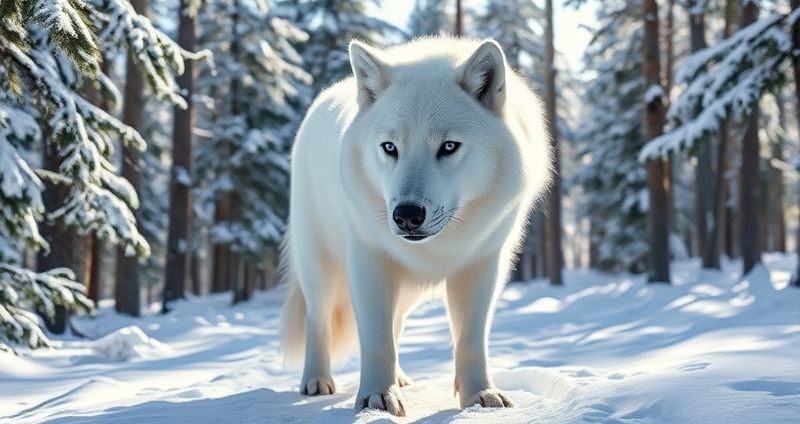Dire Wolf Brought Back to Life: Colossal Biosciences Achieves Historic De-Extinction Breakthrough
The world witnessed a groundbreaking moment in science: the return of the dire wolf, a majestic predator extinct for over 10,000 years. Colossal Biosciences, a Dallas-based biotech company, announced the successful birth of three dire wolf pups, marking what they call the “world’s first de-extinction.” This remarkable achievement blends ancient DNA, cutting-edge CRISPR technology, and a vision to reshape biodiversity. But how did they do it, and what does this mean for the future of conservation?

The Science Behind the Dire Wolf Revival
The dire wolf (Aenocyon dirus), immortalized in HBO’s Game of Thrones, once roamed North America as a top predator until its extinction around 12,500 years ago. Larger than today’s gray wolves, it boasted a wider head, thicker fur, and a powerful jaw. To bring it back, Colossal scientists started with ancient DNA extracted from dire wolf fossils—a 13,000-year-old tooth and a 72,000-year-old skull. By comparing this genetic material to the gray wolf, their closest living relative sharing 99.5% DNA, they identified key differences.
Using CRISPR gene-editing technology, the team made 20 precise edits to the gray wolf genome, introducing dire wolf traits like a larger body, white fur, and stronger jaws. These edited cells were then used to create embryos through somatic cell nuclear transfer, a cloning technique. The embryos were implanted into surrogate dogs—large, mixed-breed hounds—and after successful pregnancies, three pups were born: Romulus and Remus on October 1, 2024, and Khaleesi on January 30, 2025. Now living in a secure 2,000-acre preserve in the northern U.S., these pups represent a triumph of biotechnology.
A Milestone in De-Extinction Technology
Colossal Biosciences, founded by Ben Lamm and geneticist George Church, isn’t just reviving extinct species for novelty. “Our team took DNA from ancient fossils and made healthy dire wolf puppies,” Lamm told ABC News. “This is about building technologies that can transform conservation and even human healthcare.” The company, valued at $10 billion, has ambitious plans, including resurrecting the woolly mammoth by 2028 and the Tasmanian tiger.
The dire wolf project also produced unexpected benefits. During the research, Colossal developed a less invasive cloning method using blood samples, which they used to birth two litters of cloned red wolves—a critically endangered species with fewer than two dozen left in the wild. This dual success highlights how de-extinction tech could bolster efforts to save living species.

Controversy and Ethical Questions
Not everyone is celebrating. Critics argue that the massive funding—Colossal has raised $435 million—could be better spent on protecting endangered species rather than reviving extinct ones. Dr. Julie Meachen, a wolf expert, told ABC News, “The mission to save species on the brink of extinction is admirable, but is this just entertainment?” Others, like bioethicist Dr. Robert Klitzman, warn of unintended consequences: “Tinkering with genes could create a super wolf we don’t fully understand.”
Skeptics also question whether these pups are “true” dire wolves. Vincent Lynch, a biologist at the University at Buffalo, told AP News, “You can make something look like a dire wolf, but it won’t perform the same ecological role in today’s world.” Colossal counters that their wolves are functional hybrids, not exact replicas, designed to test de-extinction’s feasibility.
What’s Next for De-Extinction?
The dire wolves—named after Roman mythology and Game of Thrones—won’t roam wild anytime soon. For now, they’re under close watch in captivity, cared for by a team of experts behind zoo-grade fencing. But Colossal’s vision extends beyond wolves. Partnerships with Indigenous groups, like the MHA Nation, aim to restore species to ancestral lands, while collaborations with conservationists target biodiversity hotspots like North Carolina’s red wolf population.
This breakthrough raises big questions: Can de-extinction repair ecosystems damaged by human activity? Or does it distract from urgent conservation needs? As Beth Shapiro, Colossal’s chief scientist, told CNN, “We’ve proven we can do this. Now, we must ensure it benefits the planet.”
Conclusion: A New Era of Science
The rebirth of the dire wolf is more than a scientific stunt—it’s a glimpse into a future where extinction might not be forever. With investors like Peter Jackson and Paris Hilton backing Colossal, and technologies like CRISPR advancing rapidly, we’re entering uncharted territory. Whether it’s dire wolves, woolly mammoths, or endangered species, one thing is clear: the line between past and present is blurring, and the possibilities are as thrilling as they are uncertain.
From: Sweetashoneytees
